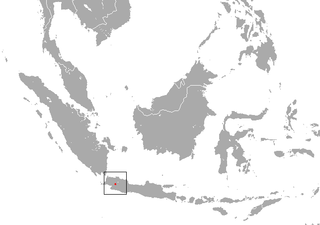
A species that is extinct in the wild (EW) is one that has been categorized by the International Union for Conservation of Nature as only consisting of living members kept in captivity or as a naturalized population outside its historic range. Classification requires exhaustive surveys conducted within the species' known habitat with consideration given to seasonality, time of day, and life cycle. Once a species is classified as EW, the only way for it to be downgraded is through reintroduction.

The Somali hedgehog is a species of mammal in the family Erinaceidae. It is endemic to Somalia and Somaliland. The Somali hedgehog is nocturnal.

The Oriental shrew is a species of mammal in the family Soricidae. It is endemic to Indonesia.

The Caucasian shrew is a species of mammal in the family Soricidae. It is found in Armenia, Russia and Turkey.
Macroperipatus insularis is a species of velvet worm in the Peripatidae family. It is found in Jamaica, and Hispaniola. The original description of this species is based on a female specimen, 55 mm long, with 30 pairs of legs.
Speleoperipatus is a monospecific genus of velvet worm in the Peripatidae family, containing the single species Speleoperipatus spelaeus. This species is a pale greenish yellow, almost white, with 22 or 23 pairs of legs and no eyes. Specimens range from 27 mm to 34 mm in length. The minimum number of leg pairs found in this species (22) is also the minimum number found in the neotropical Peripatidae. This velvet worm is viviparous, with mothers supplying nourishment to their embryos through a placenta.
Bothriembryon bradshaweri is a species of tropical air-breathing land snail, terrestrial pulmonate gastropod mollusk in the family Bothriembryontidae. This species is endemic to Australia.

Bothriembryon is a genus of tropical air-breathing land snails, terrestrial pulmonate gastropod mollusks in the family Bothriembryontidae.
Bothriembryon brazieri is a species of tropical air-breathing land snail, terrestrial pulmonate gastropod mollusk in the family Bothriembryontidae. This species is endemic to Australia.

Bothriembryon glauerti is a species of tropical air-breathing land snail, terrestrial pulmonate gastropod mollusk in the family Bothriembryontidae. This species is endemic to Australia.
Bothriembryon irvineanus is a species of tropical air-breathing land snail, terrestrial pulmonate gastropod mollusk in the family Bothriembryontidae. This species is endemic to Australia.
Bothriembryon praecelcus is a species of tropical air-breathing land snail, terrestrial pulmonate gastropod mollusks in the family Bothriembryontidae. This species is endemic to Australia.
Bothriembryon spenceri is a species of tropical air-breathing land snail, terrestrial pulmonate gastropod mollusk in the family Bothriembryontidae, and is endemic to Australia.
Bothriembryon whitleyi is a species of tropical air-breathing land snail, terrestrial pulmonate gastropod mollusk in the family Bothriembryontidae. This species is endemic to Australia.

Bothriembryontidae is a family of air-breathing land snails, terrestrial pulmonate gastropod mollusks in the superfamily Orthalicoidea.
Bothriembryon sophiarum is a species of tropical air-breathing land snails, terrestrial pulmonate gastropod mollusc in the family Bothriembryontidae. This species is endemic to Australia.







